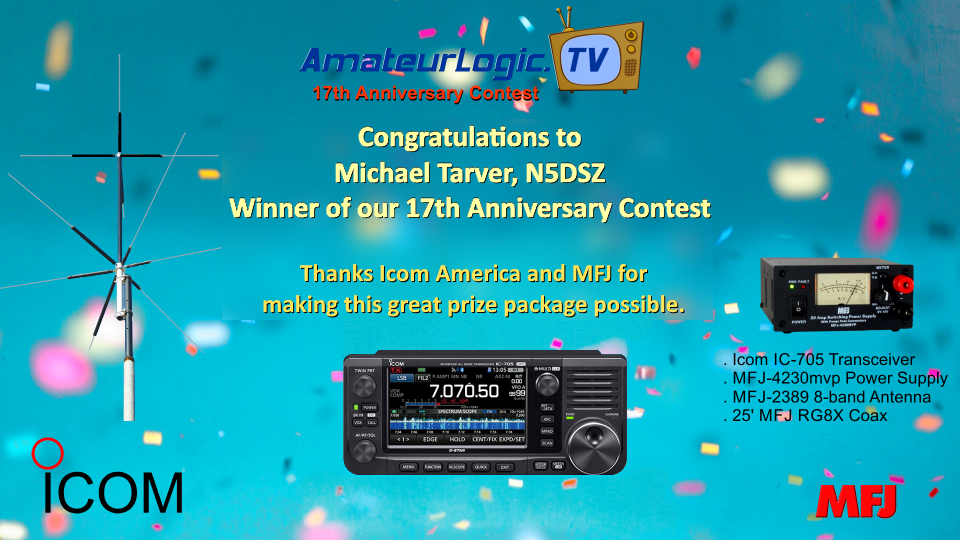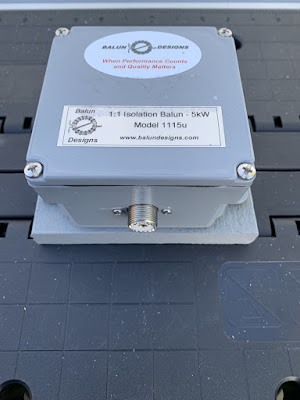 Time to add a balun.
Time to add a balun.
When I moved to the East coast from Ontario at the new QTH I purchased and installed an EndFed antenna and it worked great for me. It was a huge step up from the condo balcony mag loop antenna. The EndFed is a compromise-type antenna and does come with some issues. The main issue is (if you don't use a counterpoise) the coax shield is used as the counterpoise. This can cause some issues and an isolation balun is needed in the shack. I purchased a quality isolation balun from balun designs to take care of the feed line issues. In time I did install a counterpoise but it's not that effective when your Endfed goes from 10m-80m.
I still had some RFI issues in the shack that ferrites did an excellent job in looking after. I still had some off-and-on issues with our electronic washing machine, the motion sensor light on the shed and some Google home devices. I then moved from the EndFed to a vertical antenna the Hustler 4BTV antenna. In the manual for the 4BTV, it is advised if you have any RFI issues due to the coax radiating RF place an isolation balun at the antenna. It seemed as time passed I was issue free. 
Drainage holes 1/16th
Now and then I started to notice while operating my Icom 7610 in CW mode I would have my N1MM contest program lock up. There was no rhyme or reason as to when this happened, what power level and what band I was on. I could make it through a CWops mini-test of an hour with no issues. The next CWops mini contest I had nothing but issues. I also noticed when using my VPN on the PC I would have the VPN disconnect and then reconnect messages coming up as I transmitted. I was reading online when coax radiates RF it can be very hit-and-miss as to when it happens and what is affected each time. This sounded like the issue I was having and I decided to place the isolation balun at the base of the 4BTV vertical.
Once the isolation balun was installed I am RF free and have been for over a month now. My electronic washing machine, N1MM logger and VPN connection have no problems. 
Waterproof connections
I had to take into consideration some precautions when putting the isolation balun outdoors. It was recommended to drill 2 1/16 holes in the bottom so any condensation would not build up inside. Also around all PL-259 connections, I waterproofed them with self-amalgamating tape.
Mike Weir, VE9KK, is a regular contributor to AmateurRadio.com and writes from New Brunswick, Canada. Contact him at [email protected].
 LHS Episode #485: QSLing Deep Dive
LHS Episode #485: QSLing Deep Dive
Hello and welcome to Episode 485 of Linux in the Ham Shack. In this episode, the hosts discuss the art and science of sending and receiving QSL cards, either physically or digitally. There are several methods and it can be something of a chore to navigate. We hope you enjoy this episode and have a great week.
73 de The LHS Crew
Russ Woodman, K5TUX, co-hosts the Linux in the Ham Shack podcast which is available for download in both MP3 and OGG audio format. Contact him at [email protected].
 Contest Winner
Contest Winner

Congratulations to Michael Tarver, N5DSZ.
He’s the winner of our 17th Anniversary Contest.
And a big thanks Icom America and MFJ for making this possible.
George Thomas, W5JDX, is co-host of AmateurLogic.TV, an original amateur radio video program hosted by George Thomas (W5JDX), Tommy Martin (N5ZNO), Peter Berrett (VK3PB), and Emile Diodene (KE5QKR). Contact him at [email protected].
 A weekend of CW
A weekend of CW
If you were on the radio this weekend and are a CW buff then you know some QSO parties were in full swing along with the WAG (worked all Germany) contest were on. Since my blog title has changed to "The world of CW" you may have guessed that I was involved in something by the way of CW this weekend.
I decided to join in on the WAG contest, it's always very well attended, starts Saturday noon my time and ends Sunday noon. The German ops are great at CW and it gives me more practice at running in a CW contest. For the first time, I had no Murphy moments, no RF getting into anything to cause me side issues it sure was a nice change. I will be blogging in the near future as to what I ended up doing to get rid of my what seemed never ending surprise RF issues.
In the picture above it shows how I use the Icom 7610 in contests.
- I have 2 band scopes up (VFO A and VFO B) at the same time the operating band (top slice) and the is it open yet band (bottom slice)
- On the left-hand side tabs you will see "BK-IN FULL" or full break-in turned on. This allows me while calling CQ contest to hear the receive for very short times while transmitting. If a station starts to call me I can hear them and stop my transmitting. It takes some time to get used to but is a great tool.
- On the band, I am operating (15m in this case VFO A) I have the band edges set to 21.000-21.020 in a contest it can get very busy with signals and this visually spaces them out so when searching and pouncing you can click and tune easy.
- The bottom slice (VFO B) the band edges are very wide so I can see the full picture of the band to see if it has opened up.
- On VFO A the 15m band I am calling CQ contest or running as its called. I have the bandwidth set to 400hz. (seen at top BW 400) I do this as some ops come back off frequency and I have no issues hearing them. If I get spotted on a cluster and all hell breaks loose with stations calling me that BW goes to 200hz. if not you just hear a big mess of calls.
-Some time ago I read a piece about the Icom 7610 contest radio settings. It was stated to use your audio peak filter (APF) set to mid-range, put the noise reduction on (NR), CW filters to either 600, 400 or 200hz and set to sharp not soft and to keep the internal ATU on as they said it can act as a filter. I do all but the last part regarding the ATU. My SWR on all bands is from 1.1 to 1.5. Anyway, I was shocked by just having the APF and NR turned on and how much of a difference it made. At one point in the contest not sure how it happened but the APF and NR were turned off. I was calling CQ contest and stations were coming back to me but they were right at the noise floor and many repeats were needed to make the contact. I then noticed after about 10 very difficult contacts the APF and NF were off. I put them back on and what a joy again.
Well below is my score and I have to say that before the contest I had sugar plums dancing in my head with a high score but it turned out it was more like roasted chestnuts. Nothing wrong with that and I did have a blast.
Mike Weir, VE9KK, is a regular contributor to AmateurRadio.com and writes from New Brunswick, Canada. Contact him at [email protected].
 LHS Episode #484: The Weekender XCVII
LHS Episode #484: The Weekender XCVII
It's time once again for The Weekender. This is our departure into the world of hedonism, random topic excursions, whimsy and (hopefully) knowledge. Thanks for listening and, if you happen to get a chance, feel free to call us or e-mail and send us some feedback. Tell us how we're doing. We'd love to hear from you.
73 de The LHS Crew
Russ Woodman, K5TUX, co-hosts the Linux in the Ham Shack podcast which is available for download in both MP3 and OGG audio format. Contact him at [email protected].
 Recent Crystal Radio DX Group ‘Listening Event’
Recent Crystal Radio DX Group ‘Listening Event’
 |
| Crystal Shortwave Receiver of Al Klase (N3FRQ) |
The Facebook Crystal Radio DX Group’s fall listening event was held two weekends ago over a two-night listening period. Unlike last year’s event, this was not a contest but rather a leisurely opportunity for members to take some time to see what they could hear with their setups. Also unlike last year, this one introduced and encouraged members to see what they might hear on shortwave! Since circuits losses are measurably much higher as you climb above the broadcast band, audio amplification (AF) was permitted to encourage members to give it a try as this was a whole new region to explore for most of us.
Oct 1
Some of the BCB and SW construction inspired by the recent listening event is shown below. For more information and more sets, please visit the Facebook Group and consider taking part in our next event, sometime in December ... maybe you can build the perfect SW tuner!
 |
| Kasey Jean Double-Tuned Loopstick BCB Tuner |
 |
| James Kern Double-Tuned BCB Tuner |
.jpg) |
| Ferhat Yavas Shortwave Tuner |
 |
| Armando Anazco BCB Tuner |
 |
| Doug Allen (K4LY) Shortwave Tuner |
Steve McDonald, VE7SL, is a regular contributor to AmateurRadio.com and writes from British Columbia, Canada. Contact him at [email protected].
 AmateurLogic 174: 17 Year Anniversary
AmateurLogic 174: 17 Year Anniversary
AmateurLogic.TV Episode 174 is now available for download.
Join the AmateurLogic crew as we celebrate 17 years.
Announcing the winner of the Icom IC-705 portable transceiver and MFJ 8-Band Compact Antenna package. RSP Spectrum Analyzer, Open-Weather on-line satellite image decoder, Irwin Vice Grip Wire Strippers, and a visit from Peter, VK3PB.
George Thomas, W5JDX, is co-host of AmateurLogic.TV, an original amateur radio video program hosted by George Thomas (W5JDX), Tommy Martin (N5ZNO), Peter Berrett (VK3PB), and Emile Diodene (KE5QKR). Contact him at [email protected].





















